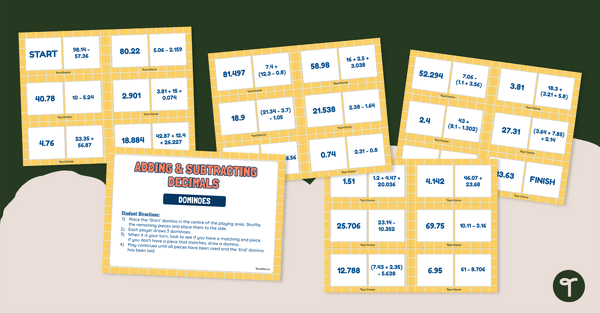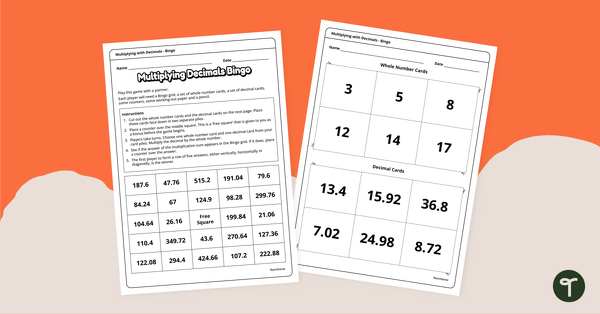Decimal Operations Teaching Resources
Teach decimal operations this school year with worksheets, activities and more — all created by teachers to help your students understand how to add, multiply, subtract and divide decimals!
Aligned with the Australian maths curriculum and created just for Aussie teachers, this collection of printable and digital teacher resources has everything you need for your lesson plans — we've even got differentiation covered!
Are you new to teaching decimal operations? Looking for a quick refresher? Read on for a primer from our teacher team on how to handle all four operations!
How Do You Add Decimals?
Let's start with one of the simplest operations when it comes to decimals: adding.
- Line up the decimal points of the numbers to be added.
- Add the numbers as if they were whole numbers.
- Place the decimal point in the sum directly below the decimal point in the original numbers.
How Do You Subtract Decimals?
Subtracting decimals is pretty similar to adding, although the operation is different. Here's how it works:
- Line up the decimal points of the numbers to be subtracted.
- Subtract the numbers as if they were whole numbers.
- Place the decimal point in the difference directly below the decimal point in the original numbers.
How Do You Divide Decimals?
Whether you're trying to find the average of a set of numbers that include decimals or determining the unit price of an item on the shelves at the chemist, being able to divide decimals has plenty of real-world applications for students.
The basic process of dividing decimals follows the same basic principles as dividing whole numbers, with one additional step — you need to adjust the decimal point in the divisor (the number you are dividing by) and the dividend (the number you are dividing) so that the divisor becomes a whole number.
Here's how to do it:
- If the decimal point is missing from one or both numbers, add it to the end of the number(s) so that they are both decimals.
- For example, if you are dividing 72 by 0.6, add a decimal point to 72 to make it 72.0.
- Move the decimal point in the divisor to the right until it becomes a whole number. At the same time, move the decimal point in the dividend the same number of places to the right. Keep track of how many places you moved the decimal point.
- Divide the adjusted dividend by the adjusted divisor (now a whole number), just like you would with whole numbers.
- Move the decimal point in the quotient (the answer to the division problem) back to the left the same number of places you moved the decimal point in step 2.
How Do You Multiply Decimals?
Multiplying decimals can help your students calculate the total cost of items at the store, determine the amount of a discount or tax and a whole lot more. The process to do it is simple, once they get it down!
- Ignore the decimal points and multiply the numbers as if they were whole numbers.
- Count the total number of decimal places in the numbers being multiplied.
- Starting from the right of the product, count that many places and insert a decimal point.
- Plus Plan

Adding and Subtracting Decimals Dominoes for Year 6
Use this year 6 maths game of dominoes to strengthen computation skills by adding and subtracting decimals through the thousandths place.
- Plus Plan

Number Talks – Decimal Operations Task Cards
Explore decimal operations with your students using this set of 26 number talk task cards.
- Plus Plan

Multiplying with Decimals Bingo Game
Get your students multiplying decimals by whole numbers with this engaging Bingo game.